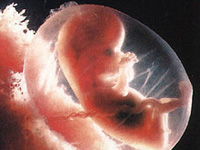Human embryos never have any gills or any tails
Scientists believed in the middle of the 19th century that the human embryo went through all stages of the evolution of the species. Scientific theories of that time said that the impregnated ovum grows into the freshwater hydroid, turns into the gilled fish, develops into a tailed animal and finally becomes a human being.

It was proved long ago that the hypothesis was incorrect, to put it mildly.
The story began in 1866, when German biologist Ernst Haeckel decided to find a proof of Darwin ’s theory. Having studied human and animal embryos of different ages, he found many similarities between them. The scientist considered that the tail and the gills of the human embryo were not just a mere coincidence. He eventually concluded that each living being quickly repeats the development of its species in the prenatal development.
The church did not like Haeckel’s ideas, although his colleagues renamed it into the biogenetic law. Unfortunately, it never became possible to prove the law in its original wording. The facts, which seemed to be indisputable at first sight, turned out to be wrong under a closer inspection.
Embryologists have revised the Haeckel-Muller law, although its myths still live today.
It seems that the gills of the human embryo give a precise indication of the place of the human being on the evolution tree. However, Haeckel only described the outward appearance of the embryos and left all the details of their internal structure aside. The scientist mistook the gills for the folding tissue which preceded the head and the neck. The folds became traditionally known as gill arches, although it would be correct to refer to them as visceral arches. The human embryo has no gill openings similar to those of cold-blooded animals.
The embryos are often pictured with tails. It was revealed that the human embryo has a larger number of the vertebrae in comparison with adult humans – 38 against 33-34. The future skeleton undergoes a slight transformation afterwards and the baby sees the light having the usual number of spinal bones. Like the nervous system, the axial skeleton of the embryo grows slower than other organs and tissues. That is why the embryo has several large sizes in comparison with the whole tiny organism.
There were many incidents in medical practice when children were born having small tails. Many still take such tails for the attributes of Homo sapiens distant ancestors. In India , such children were believed to be messengers from monkey god Hanuman. Thousands of pilgrims would come to touch the holy tail. In Europe , however, the fate of such children was very sad.
Researchers determined that the tail of such children had neither muscles nor vertebrae – it was the embryo tissue which incidentally found itself on the wrong place.
Newborns may often have lanugo on their bodies. Lanugo appears during the 28th week of pregnancy and disappears by the 40th week. Is it something that people inherit from fluffy apes? Everything that happens in the human organism happens for a reason. The underdeveloped hair performs a protective function – the hair comes in handy for the baby if it is born prematurely, for the thermal control system may not be ready for the cold air.
Embryologists are unanimous in their opinion nowadays: the human embryo is a human being, not any other creature from the very start of its life. It goes without saying that humans can often be compared with animals: we are made of cells, we breathe oxygen, we have the head and four limbs, and the Darwin theory is still recognized as official. Modern scientists compare different species and study embryos by their genes, which manifest themselves in typical places of the embryo. For example, the genes producing the proteins of the nervous tissue become more active at the cephalic pole of the fetus indicating the location of the future brain.
Subscribe to Pravda.Ru Telegram channel, Facebook, RSS!


